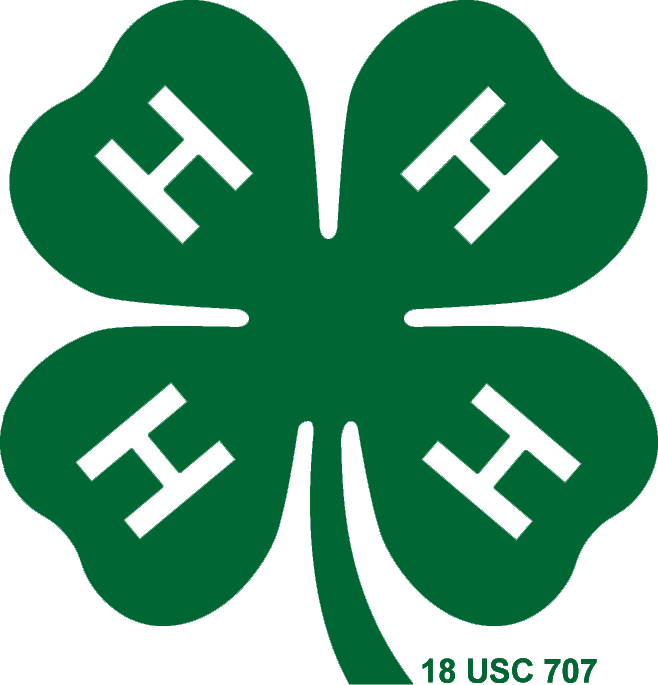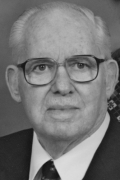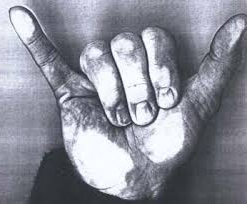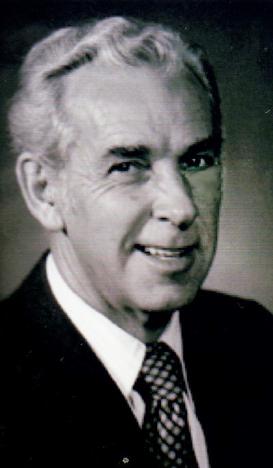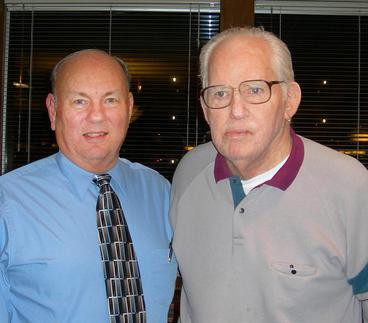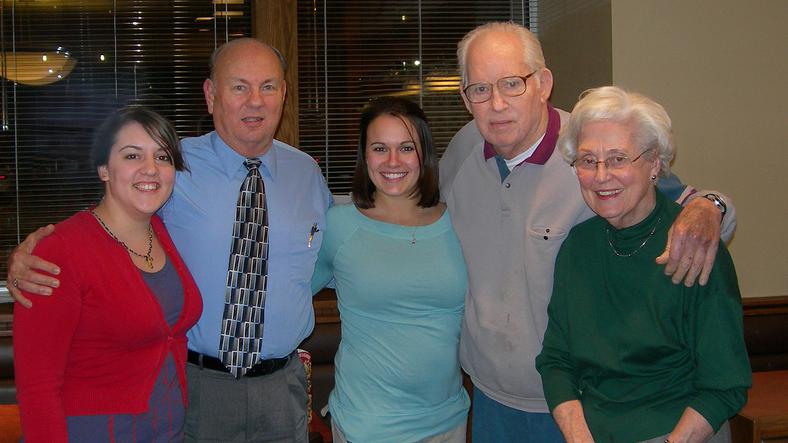DELAWARE 4-H STATE CAMP
CAMP BARNES
In 1948, Sam Gwinn arrived on the Delaware scene from West Virginia and was appointed as Sussex County Extension Agent. One of his first concerns was that he wanted the 4-H youth in Delaware to have the same opportunity that he had experienced as a youth with an overnight camping program. With all of his accomplishments that followed, Dr. Gwinn was most proud of his work in opening the 4-H camp at Camp Barnes. He was fully aware of how his West Virginia camp experiences had a profound effect on him. Based on those experiences, he duplicated many of the traditions from the West Virginia camp in starting the Delaware camp.
Delaware 4-H Camp - The Beginning ~ 1948
Dr. Sam Gwinn 1919 - 2012
In 1951, he became the State 4-H Director and served until 1960 with a sabbatical leave to study for his doctorate at the University of Wisconsin. He later became the director of the Cooperative Extension at the University of Delaware. He held that position for 22 years until his retirement. Dr. Gwinn was named to the 4-H National Hall of Fame in 2003, the first Delawarean ever to be so honored.
According to the Laws of the Council Circle, anyone who wishes to speak during a Council Circle must stand, use the Woodcraft Sign, and be recognized by the leader. This is a way to show respect to the leader and to the other groups. The Woodcraft Sign also communicates that you have something important to say. The Woodcraft Sign is given with the right hand, with all fingers closed except the little one (“pinky”) and the thumb. Raise your hand level with your head, and form your hand to make the Woodcraft Sign.
Woodcraft Sign
Symbolism of the Woodcraft Sign: The Thumb and the “Pinky” represent DEER ANTLERS (Nature). The closed part of the hand (three fingers) represents the three parts of the “Shield of Honor” (LOVE, TRUTH, and LOYALTY)
The West Virginia 4-H camp was basically replicated in Delaware with the same fundamentals. Not only did Sam come from West Virginia, but he also "drafted" Jim Baker from West Virginia. During the early years of camp, it was typical to have a Song Leader from West Virginia visit Delaware during camp to act as the song Leader here. The Woodcraft Sign and the Laws of the Council Circle were the same.
Laws of the Council Circle
1. The Council Circle should be unbroken. (Campers should sit with elbows touching. When doing so they make better "medicine.")
2. The Word of Honor is sacred.
3. Silence is observed while another is speaking.
4. Only the ISHKATAY, "Keeper of the Fire" may enter the Council Circle without first obtaining permission from the Chief.
5. There shall be no light but the Great Light, except by permission from the Chief.
6. Wishing to speak, the brave rises, makes the Woodcraft sign, says, "Oh Chief," then awaits the Chief's recognition. Thus given; he speaks his name, the name of the tribe, and makes his request.
7. In expressing approval, campers say "How-How," disapproval is "Nitchie-Nitchie." This is a How-How camp.
8. The Council Circle shall be 24 feet in diameter.
9. Silence is observed while the ISHKATAY lights the fire.
10. The wishes of the tribe are expressed through the chief.
One story that Sam related to me was that when he was a first year camper as a 10 year old, he wanted to state a “Law of the Council” when it was requested. He said that he was nervous going into the Council Circle, but had practiced several times during the day. When he was in the circle, he was even more nervous and afraid that he would do something wrong. There were the details of rising, showing the Woodcraft sign, stating your name and your group and getting attention of the leader. Once recognized, then the “Law of the Council” was stated. Of course everything went well, but he still admitted that it was a challenge for him as a 10 year old. The result was that he could see the value of the experience that he never forgot and he could see and understand the leadership role that camp offered in building character.
Major 4-H Efforts and Honors: Delaware State 4-H Leader. A product of the West Virginia 4-H program, he further developed the Delaware 4-H overnight camping program. He was instrumental in bringing together a group of Delaware business leaders and 4-H supporters to form the Delaware 4-H Foundation, Inc. Since 1978, the Foundation has raised hundreds of thousands of dollars for Delaware 4-H Youth Development programs. National 4-H Congress Headquarters Chair and National 4-H Conference Planning Committee for several years. Helped to establish NAE4-HA. Jim Baker Memorial Award is presented in his honor for distinguished service to Delaware 4-H.
Jim Baker served as a 4-H agent in West Virginia from 1950-1958, then came to Sussex County, DE, as a County 4-H Agent for two years before becoming State 4-H Leader. He held that position until his death from cancer in 1981. He served on and often chaired many regional 4-H committees and National 4-H Conference and Congress Committees. At Thanksgiving he would be in Chicago handling some aspect of National 4-H Congress, often involved in program or headquarters. He was a fixture at National 4-H Conference, most often involved in the delegate's program. Jim was involved with other northeast colleagues in establishing the NAE4-HA and hosting the Atlantic City meeting.
Using his West Virginia 4-H and overnight camping experience, Jim developed a Delaware camping program that focused on youth and developing teen leaders. For many rural campers, it was their first overnight away from home. He brought college-age camp counselors from West Virginia to work with his counselors. Delaware 4-H teens attended West Virginia Older Youth Conference to gain leadership skills and knowledge. He mentored new staff, encouraging them to develop close working relationships with volunteers, the backbone of the 4-H program. He brought together business leaders and 4-H supporters to form the Delaware 4-H Foundation, Inc., which has raised hundreds of thousands of dollars for Delaware 4-H since 1978.
As I have mentioned, Sam Gwinn "recruited" another individual from West Virginia to help build the Delaware program. Jim Baker was that individual and he was inducted to the 4-H National Hall of Fame in 2005 as a result of his contributions to the Delaware 4-H program. The information that follows is a brief summary of some of his accomplishments.
James O. Baker 19?? - 1981
I will be providing a lot more information about Jim Baker on this website because of his great influence on the Delaware 4-H members. Just to give you an example, I was fortunate to be selected as one to attend the West Virginia Camp. I also attended the conference in New Jersey mentioned above. I attended National 4-H Conference with Jim.
On a personal note, Jim was avid archer. At times, we would go to an archery range where there were several challenges. (It was somewhat like a golf course as you progressed from one target station to the next.) Our interest in archery was also a part of camp. When Jim sold his bow, I bought it and I still have it as pictured.
EB with Delaware 4-H camp founder, Sam Gwinn
As a result of a "one-in-a-million" chance meeting, Monica (center) was fortunate to meet Sam and his wife Dot (Dorothy) in a restaurant. She soon learned that she was speaking to the founder of the 4-H camp where she was a counselor at the time. Here is a picture of a later visit with Ashley, also a camp counselor, EB, Monica, Sam and Dot (from left to right).
